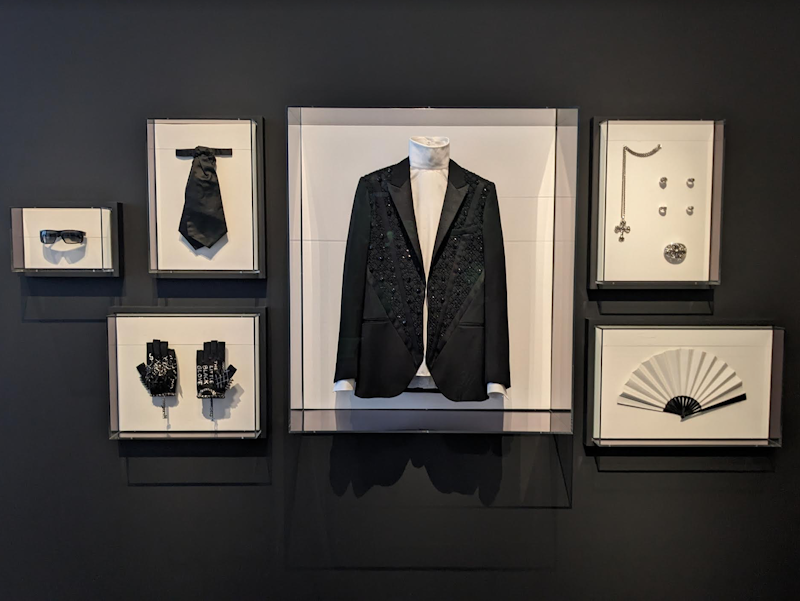When most people think about Karl Lagerfeld, a specific, highly-branded image comes to mind. Long hair, slicked back in a ponytail, and framed by black glasses. A black jacket, worn with a collared, white button-up shirt and tie, and black pants. Fingerless driving gloves (also usually in black), and a mix of silver-toned jewelry, expertly positioned around his neck and torso. Lagerfeld wore, and perfected his chosen uniform over the course of several decades, successfully associating his name with this outfit well past his death in 2019.
They’ll also tell you that Lagerfeld was head of the illustrious French fashion house, Chanel, which he’s credited for making the luxury powerhouse that it is today. Most, however, are less likely to know that he’d also served as the head of Chloé twice during the span of his lengthy career, and at the time of his death he was also the creative director of Fendi, as well as his own eponymous brand. Even fewer will know of his earlier work at Balmain and Patou, or that he won the prestigious International Woolmark Prize in 1955, catapulting his career at the age of 22. The Metropolitan Museum of Art’s current exhibition, Karl Lagerfeld: A Line of Beauty, presents a relatively comprehensive, yet guarded story of the designer's 65-year year career, by including a selection of the brands and objects that he not only worked on, but with which he became synonymous.
Divided into nine sections that categorize his vast body of work into themes, or lines (“Feminine/Masculine,” “Rococo/Classical,” “Ornamental/Structural” are three), the exhibition starts out with one of the most intriguing objects— or rather, collection of objects— on display: Lagerfeld’s messy desk. Full of books, documents, and sketches, his original desk’s composition is recreated with his own belongings to resemble the way it looked when Annie Liebovitz photographed it in 2018; the photo’s featured next to it, for a side-by-side comparison. Although this isn’t something that Lagerfeld designed (at least not in the explicit, conscious sense of the word “design”), it provides a window into the complex mind of a man who created hundreds of comprehensive seasonal collections, presented at increasingly complicated runway shows, which earned him the nickname “Kaiser Karl.”
Many of the objects are shown alongside reproductions of Lagerfeld's design sketches, providing an engaging point of comparison between their inception and their end result. In some cases, images of historical references that served as inspiration, such as a well-known illustration of the infamous dandy Beau Brummell, provide additional compelling insight into Lagerfeld's design process.
The exhibition presents a well-rounded mix of the designer's most recognizable, standard work alongside that of his more daring, avant-garde pieces. Instantly recognizable Chanel tweeds share the spotlight with meticulously crafted Fendi furs, such as the “Lassie and the Prince” silk gown with a Kay Nielsen-inspired scene made of appliqued, shaved mink flowers. Although many of the garments conformed to Lagerfeld’s ubiquitous, personal black-and-white color scheme, there were plenty of colorfully eye-catching pieces that demonstrate the designer’s ability to thrive in multiple different design languages. Custom-made mannequins, created especially for this exhibition by Bonaveri, serve as a nod to Lagerfeld’s collection of sculptures by Art Deco artist Gerhard Schliepstein (1886–1963).
The final sections of the exhibition are purposefully reductive, leaning heavily into Lagerfeld’s exaggerated, even satirical exercises in self-branding. A small room that hosts the artist Baillee Walsh’s collection of 81 iPhones that all featured the same, alternating loop of videos of Lagerfeld laughing in a seemingly staged manner, followed by short quotes—“Karlisms”—felt haphazardly added to the exhibition as social media fodder. The final installation, an assemblage of Perspex boxes that each contain an element of his uniform, serve as a distillation of the late designer, who expertly self-deprecated himself by stating: “When I was younger, I wanted to be a caricaturist. In the end, I’ve become a caricature.”
One major aspect of Lagerfeld’s career that the curators intentionally left out of the exhibition were his many instances of provocative behavior that, justifiably, upset many people both in and outside of his field. The list is too long to include in an exhibition review such as this, but include misogynistic, and body-negative and fatphobic comments, and hiding his family’s Nazi past. Inquisitive minds will find that Yahoo! writer Tayler Adigun neatly summed up a handful of the controversies in an article in which I was quoted. Adigun’s piece is just one of many that was published around the exhibition’s opening, prompting many to question whether there should be an exhibition about Lagerfeld at all.
Fashion tends to “trickle down” from the top to bottom; from haute couture and luxury runways to mass market retailers, and from influencers to the general public. Through such a long career, and at so many prominent brands, Lagerfeld had so much power and influence on what people were wearing—from the top to the bottom—that seemingly anything could be Karl Lagerfeld-inspired. His body of work is undoubtedly worth admiring, but also should be scrutinized, making this exhibition not one to miss, but also not one to incautiously gloss over.
—Karl Lagerfeld: A Line of Beauty is on view until July 16, 2023, at the Metropolitan Museum of Art’s Anna Wintour Costume Center in New York.
—Doris Domoszlai-Lantner is an historian, archivist, and professor of fashion studies. Read more about her work at www.dorisddl.com and follow her on Instagram and Twitter @doris_ddl.

